International Journal of Image, Graphics and Signal Processing @ijigsp
Статьи журнала - International Journal of Image, Graphics and Signal Processing
Все статьи: 1157
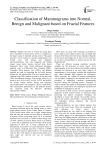
Classification of Mammograms into Normal, Benign and Malignant based on Fractal Features
Статья научная
Modern life style of women has made them more vulnerable to breast cancer and it is considered as the largest cause of mortality among women. This paper presents a novel method to classify mammograms into normal ones, with benign and malignant microcalcifications, and with malignant and benign tumors using fractal features derived from fractal dimension. Here, three fractal dimension estimation methods such as Differential Box Counting (DBC), Triangular Prism Surface Area (TPSA) and Blanket methods are used for computing the six fractal features utilized for the classification. The new fractal feature f6 obtained using TPSA method is found to be the best with 100% classification accuracy. The average value of f6 is found to be 0.1110, 0.2875, 0.4743, 0.5271 and 0.8558, for normal, benign masses, benign and malignant microcalcifications and malignant masses respectively. The classification performance of the different features was analyzed using the Receiver Operating Characteristics (ROC).
Бесплатно
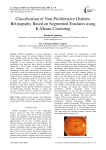
Статья научная
Diabetic retinopathy is a severe complication retinal disease caused by advanced diabetes mellitus. Long suffering of this disease without threatment may cause blindness. Therefore, early detection of diabetic retinopathy is very important to prevent to become proliferative. One indication that a patient has diabetic retinopathy is the existence of hard exudates besides other indications such as microaneurysms and hemorrhages. In this study, the existence of hard exudates is applied to classify the moderate and severe grading of non-proliferative diabetic retinopathy in retinal fundus images. The hard exudates are segmented using K-means clustering. The segmented regions are extracted to obtain a feature vector which consists of the areas, the perimeters, the number of centroids and its standard deviation. Using three different classifiers, i.e. soft margin Support Vector Machine, Multilayer Perceptron, and Radial Basis Function Network, we achieve the accuracy of 89.29%, 91.07%, and 85.71% respectively, for 56 training data and 56 testing data of retinal images.
Бесплатно
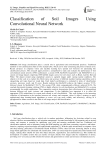
Classification of Soil Images Using Convolutional Neural Network
Статья научная
Soil image classification plays a crucial role in agricultural and environmental practices. Traditional methods of soil classification often involve manual labor, which can be time-consuming and prone to human error. Recent advances in computer vision and machine learning have opened new horizons for automating this classification process. This research paper presents a comprehensive study and evaluates the performance of four convolutional neural network (CNN) architectures a custom CNN, ResNet50, InceptionV3, and MobileNetV2 on a custom soil image dataset comprising 1800 labelled images across four soil classes such as Black, Laterite, Red and White. The dataset created using smartphone camera to captured images under varying natural conditions. The objective of this work is to explore the effectiveness and accuracy of different machine learning algorithms used in categorizing soil types based on visual data. Each model’s performance is evaluated in terms of classification accuracy, precision, recall, and F1-score. Results indicate that ResNet50 achieves the highest accuracy 97.3%, followed closely by MobileNetV2 94.7%. The custom CNN, while computationally efficient, achieved 88.2%. We conclude that transfer learning with deep CNNs is highly effective for soil classification, and MobileNetV2 is a strong recommended for mobile applications. The comparative analysis demonstrates their effectiveness in distinguishing between different soil types, textures, and compositions. It also highlights how important it is to select the appropriate CNN architectures for certain tasks related to soil classification. This work belongs to the increasing collection of information at the interface between soil science and computer vision. It offers a strategy to apply sophisticated deep learning-based algorithms to assess soil type more reliably and effectively, serving as a springboard for future research in the field of soil image analysis and classification.
Бесплатно
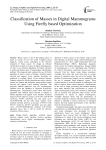
Classification of masses in digital mammograms using firefly based optimization
Статья научная
Breast cancer is one of the leading causes of death in women all over the world. Computer based diagnosis system assists radiologist in the effective treatment of breast cancer. To design an efficient classification system for masses in digital mammograms, we have to use efficient algorithms for feature selection to reduce the feature space of mammogram classification problem. The proposed study explores the use of Firefly algorithm to select a subset of features. Artificial neural network and support vector machine classifiers are employed to evaluate fitness of the selected features. Features selected by Firefly algorithm are used to classify masses into benign and malignant, using artificial neural network and support vector machine classifiers. The proposed method employed over 651 mammograms obtained from the Database of Digitized Screen-film Mammograms. Classification results show that Firefly algorithm with artificial neural network is superior to Firefly algorithm with support vector machine. Artificial neural network achieves accuracy of 95.23% with 94.43% sensitivity, 93.94% specificity and area under curve Az=0.965±0.008. On the other hand, support vector machine classifier achieves an accuracy of 92.47% with 96.14% sensitivity, 88.53% specificity and area under curve Az=0.951±0.009.Results obtained with Firefly algorithm shows that it will be useful for effective treatment of breast cancer.
Бесплатно
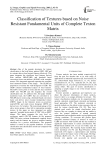
Classification of textures based on noise resistant fundamental units of complete texton matrix
Статья научная
One of the popular descriptor for texture classification is the local binary pattern (LBP). LBP and its variants derives local texture features effectively. This paper integrates the significant local features derived from uniform LBPs(ULBP) and threshold based conversion factor non-uniform (NULBP) with complete textons. This integrated approach represents the complete local structural features of the image. The ULBPs are proposed to overcome the wide histograms of LBP. The ULBP contains fundamental aspects of local features. The LBP is more prone to noise and this may transform ULBP into NULBP and this degrades the overall classification rate. To addresses this, this paper initially transforms back, the ULBPs that are converted in to NULBPs due to noise using a threshold based conversion factor and derives noise resistant fundamental texture (NRFT) image. In the literature texton co-occurrence matrix(TCM) and multi texton histogram (MTH) are derived on a 2x2 window. The main disadvantage of the above texton groups is they fail in representing complete textons. In this paper we have integrated our earlier approach “complete texton matrix (CTM)” [16] on NRFT images. This paper computes the gray level co-occurrence matrix (GLCM) features on the proposed NRFCTM (noise resistant fundamental complete texton matrix) and the features are given to machine learning classifiers for a precise classification. The proposed method is tested on the popular databases of texture classification and classification results are compared with existing methods.
Бесплатно
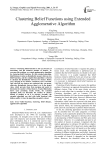
Clustering Belief Functions using Extended Agglomerative Algorithm
Статья научная
Clustering belief functions is not easy because of uncertainty and the unknown number of clusters. To overcome this problem, we extend agglomerative algorithm for clustering belief functions. By this extended algorithm, belief distance is taken as dissimilarity measure between two belief functions, and the complete-link algorithm is selected to calculate the dissimilarity between two clusters. Before every merging of two clusters, consistency test is executed. Only when the two clusters are consistent, they can merge, otherwise, dissimilarity between them is set to the largest value, which prevents them from merging and assists to determine the number of final clusters. Typical illustration shows same promising results. Firstly, the extended algorithm itself can determine the number of clusters instead of needing to set it in advance. Secondly, the extended algorithm can deal with belief functions with hidden conflict. At last, the algorithm extended is robust.
Бесплатно
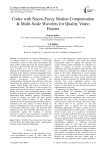
Codec with Neuro-Fuzzy Motion Compensation & Multi-Scale Wavelets for Quality Video Frames
Статья научная
Virtual Reality or Immersive Multimedia as it is sometimes known, is the realization of real-world environment in terms of video, audio and ambience like smell, airflow, background noise and various ingredients that make up the real world. This environment gives us a sense of reality as if we are living in a real world although the implementation of Virtual Reality is on a laboratory scale. Audio has attained unimaginable clarity by splitting the spectrum into various frequency bands appropriate for rendering on a number of speakers or acoustic wave-guides. The combination and synchronization of audio and video with better clarity has transformed the rendition matched in quality by 3D cinema. Virtual Reality still remains in research and experimental stages. The objective of this research is to explore and innovate the esoteric aspects of the Virtual Reality like stereo vision incorporating depth of scene, rendering of video on a spherical surface, implementing depth-based audio rendering, applying self-modifying wavelets to compress the audio and video payload beyond levels achieved hitherto so that maximum reduction in size of transmitted payload will be achieved. Considering the finer aspects of Virtual Reality we propose to implement like stereo rendering of video and multi-channel rendering of audio with associated back channel activities, the bandwidth requirements increase considerably. Against this backdrop, it becomes necessary to achieve more compression to achieve the real-time rendering of multimedia contents effortlessly.
Бесплатно
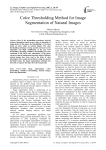
Color Thresholding Method for Image Segmentation of Natural Images
Статья научная
Most of the thresholding procedures involved setting of boundaries based on grey values or intensities of image pixels. In this paper, the thresholding is to be done based on color values in natural images. The color thresholding technique is being carried out based on the adaptation and slight modification of the grey level thresholding algorithm. Multilevel thresholding has been conducted to the RGB color information of the object extract it from the background and other objects. Different natural images have been used in the study of color information. The results showed that by using the selected threshold values, the image segmentation technique has been able to separate the object from the background.
Бесплатно
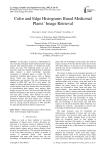
Color and Edge Histograms Based Medicinal Plants' Image Retrieval
Статья научная
In this paper, we propose a methodology for color and edge histogram based medicinal plants image retrieval. The medicinal plants are divided into herbs, shrubs and trees. The medicinal plants are used in ayurvedic medicines. Manual identification of medicinal plants requires a priori knowledge. Automatic recognition of medicinal plants is useful. We have considered medicinal plant species, such as Papaya, Neem, Tulasi and Aloevera are considered for identification and retrieval. The color histograms are obtained in RGB, HSV and YCbCr color spaces. The number of valleys and peaks in the color histograms are used as features. But, these features alone are not helpful in discriminating plant images, since majority plant images are green in color. We have used edge and edge direction histograms in the work to get edges in the stem and leafy parts. Finally, these features are used in retrieval of medicinal plant images. Absolute distance, Euclidean distance and mean square error, similarity distance measures are deployed in the work. The results show an average retrieval efficiency of 94% and 98% for edge and edge direction features respectively.
Бесплатно
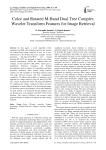
Color and Rotated M-Band Dual Tree Complex Wavelet Transform Features for Image Retrieval
Статья научная
In this paper, a novel algorithm which integrates the RGB color histogram and texture features for content based image retrieval. A new set of two-dimensional (2-D) M-band dual tree complex wavelet transform (M_band_DT_CWT) and rotated M_band_DT_CWT are designed to improve the texture retrieval performance. Unlike the standard dual tree complex wavelet transform (DT_CWT), which gives a logarithmic frequency resolution, the M-band decomposition gives a mixture of a logarithmic and linear frequency resolution. Most texture image retrieval systems are still incapable of providing retrieval result with high retrieval accuracy and less computational complexity. To address this problem, we propose a novel approach for image retrieval using M_band_DT_CWT and rotated M_band_DT_CWT (M_band_DT_RCWT) by computing the energy, standard deviation and their combination on each subband of the decomposed image. To check the retrieval performance, two texture databases are used. Further, it is mentioned that the databases used are Brodatz gray scale database and MIT VisTex Color database. The retrieval efficiency and accuracy using proposed features is found to be superior to other existing methods.
Бесплатно
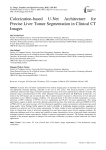
Colorization-based U-Net Architecture for Precise Liver Tumor Segmentation in Clinical CT Images
Статья научная
Accurate liver and tumor segmentation from medical imaging plays an important role in effective diagnosis and appropriate treatment planning, especially in the case of liver cancer. This research proposed a novel U-Net architecture enhanced with image colorization techniques for precise liver tumor segmentation in clinical CT images. The proposed image colorization-based U-Net, which integrates both grayscale-based and RGB-based architectures, was tested on the LiTS dataset and real clinical data. This evaluation aimed to measure its effectiveness in liver and tumor segmentation across different imaging conditions. The grayscale-based U-Net achieved high segmentation accuracy, achieving a DICE coefficient of 99.95% for liver segmentation and 90.44% for tumor segmentation. This strong performance suggests its ability to precisely delineate anatomical structures. The model also achieved an RMSE of 0.019, a PSNR of 82.14, and a pixel accuracy of 0.316, reflecting its capability to reduce reconstruction while preserving overall image quality. These findings further support the model’s reliability in challenging imaging scenarios, suggesting its potential as an effective tool for liver tumor segmentation. To further validate its real-world applicability, the model was tested on clinical data, where it effectively segmented liver and tumor regions across diverse imaging conditions. By addressing challenges such as low contrast and variability in tumor characteristics, the use of grayscale-based colorization techniques enhances feature representation, leading to improved segmentation outcomes. The findings demonstrate the potential of the proposed approach to enhance liver and tumor localization, providing a robust framework for clinical applications.
Бесплатно
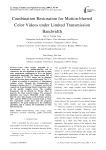
Combination Restoration for Motion-blurred Color Videos under Limited Transmission Bandwidth
Статья научная
Color video images degraded in a deterministic way by motion-blurring can be restored by the new algorithm in real-time by using color components combination to fit to the limited transmission bandwidth. The image motion PSF of each surface of YUV422 image can be obtained based on the color space conversion model. The Y, U, V planes are packed to construct a 2 dimensional complex array. Through the decomposition of frequency domain, the Y, U, V frequency can be had respectively by performing Fourier transform a time on the specific complex array. The resulting frequencies will be filtered by Wiener filter to generate the final restored images. The proposed algorithm can restore 1024x1024 24-bit motionblurred color video images at 18 ms/frame speed on GPU, and the PSNR of the restored frame is 31.45. The experiment results show that the proposed algorithm is 3X speed compared to the traditional algorithm, and it reduces the bandwidth of video data stream 1/3.
Бесплатно
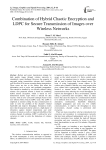
Статья научная
Robust and secure transmission strategy for high quality image through wireless networks is considered a great challenge. However, the majority of encrypted image transmission schemes don't consider well the effect of bit errors occurring during transmission. These errors are due to the factors that affect the information such as noise and multipath propagation. That should be handled by an efficient channel coding scheme. Our proposed scheme is based on combining hybrid chaotic encryption, which is based on two-dimensional chaotic maps which is utilized for data security, with an error correction technique based on the Low Density Parity Check (LDPC) code. The LDPC is employed as channel coding for data communication in order to solve the problem of the channel’s limited bandwidth and improve throughput. Simulation results show that the proposed scheme achieves a high degree of robustness against channel impairments and wide varieties of attacks as wells as improved reliability of the wireless channel. In addition, LDPC is utilized for error correction in order to solve the limitations of wireless channels.
Бесплатно
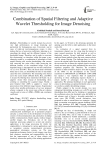
Combination of Spatial Filtering and Adaptive Wavelet Thresholding for Image Denoising
Статья научная
Thresholding in wavelet domain has proven very high performances in image denoising and particularly for homogeneous ones. Conversely, and in cases of relatively non-homogeneous scenes, it often induces the loss of some true coefficients; inducing so, to smoothing the details and the different features of the thresholded image. Therefore, and in order to overcome this shortcoming, we introduce within this paper a new alternative made by a combination of advantages of both spatial filtering and wavelet thresholding; that ensures well removing the noise effect while preserving the different features of the considered image. First, the degraded image is decomposed into wavelet coefficients via a 2-level 2D-DWT. Then, the finest detail sub-bands likely due to noise, are thresholded in order to maximally cancel the noise contribution. The remaining noise shared across the coarse detail subbands (LH2, HL2, and HH2) is cleaned by filtering these mentioned sub-bands via an adaptive wiener filter instead of thresholding them; avoiding so smoothing the acquired image. Finally, a joint bilateral filter (JBF) is applied to ensure the preservation of the different image features. Experimental results show notable performances of our new proposed scheme compared to the recent state-of-the-art schemes visually and in terms of (MSE), (PSNR) and correlation coefficient.
Бесплатно
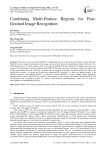
Combining Multi-Feature Regions for Fine-Grained Image Recognition
Статья научная
Fine-grained visual classification(FGVC) is challenging task duo to the subtle discriminative features.Recently, RA-CNN selects a single feature region of the image, and recursively learns the discriminative features. However, RA-CNN abandons most of feature regions, which is not only the inefficient but aslo ineffective.To address above issues,we design a noval fine-grained visual recognition model MRA-CNN,which associates multi-feature regions.To improve the feature representation,attention blocks are integrated into the backbone to reinforce significant features;To improve the classification accuracy, we design the feature scale dependent(FSD) algorithm to select the optimal outputs as the classifier inputs;To avoid missing features, we adopt the k-means algorithm to select multiple feature regions.We demonstrate the value of MRA-CNN by expensive experiments on three popular fine-grained benchmarks:CUB-200-2011,Cars196 and Aircrafts100 where we achieve state-of-the-art performance.Our codes can be found at https://github.com/dlearing/MRA-CNN.git.
Бесплатно
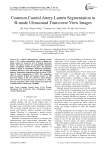
Common Carotid Artery Lumen Segmentation in B-mode Ultrasound Transverse View Images
Статья научная
To evaluate atherosclerosis, common carotid artery (CCA) lumen segmentation requires outlining the intima contour on transverse view of B-mode ultrasound images. The lumen contours are automatically segmented using a morphology method in this paper. The proposed method is based on self-adaptive histogram equalization, non-linear filtering, Canny edge detector and morphology methods. Experiments demonstrated that the merit (FOM) value of lumen segmentation is 0.705. The comparison between proposed method and manual contours on 180 transverse images of the CCA showed a mean absolute error of 0.47±0.13 mm and mean max distance of 2.08±0.63 mm respectively. These results compare favorably with a clinical need for reducing use variability.
Бесплатно
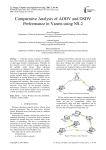
Comparative Analysis of AODV and DSDV Performance in Vanets using NS-2
Статья научная
Vehicular ad-hoc networks (VANETs) form when vehicles are equipped with devices capable of short-range wireless communication. Vehicular Ad hoc networks involve motion of nodes depending on the mobility model chosen. Three important considerations in simulation of VANETs are mobility models, network simulator and the routing protocols. Selection of appropriate mobility model for evaluating routing protocol leads to efficient simulation results. Performance of routing protocols in VANETs can be measured using four metrics; bandwidth, packet loss, throughput and scalability. This research work is based on the simulation based analysis of Vehicular Ad- hoc networks using NS-2 as the network simulator. Performance evaluation of the protocols is conducted on the basis of four defined metrics and as conclusion is made according to the simulation results.
Бесплатно
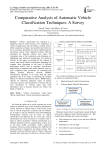
Comparative Analysis of Automatic Vehicle Classification Techniques: A Survey
Статья научная
Vehicle classification has emerged as a significant field of study because of its importance in variety of applications like surveillance, security system, traffic congestion avoidance and accidents prevention etc. So far numerous algorithms have been implemented for classifying vehicle. Each algorithm follows different procedures for detecting vehicles from videos. By evaluating some of the commonly used techniques we highlighted most beneficial methodology for classifying vehicles. In this paper we pointed out the working of several video based vehicle classification algorithms and compare these algorithms on the basis of different performance metrics such as classifiers, classification methodology or principles and vehicle detection ratio etc. After comparing these parameters we concluded that Hybrid Dynamic Bayesian Network (HDBN) Classification algorithm is far better than the other algorithms due to its nature of estimating the simplest features of vehicles from different videos. HDBN detects vehicles by following important stages of feature extraction, selection and classification. It extracts the rear view information of vehicles rather than other information such as distance between the wheels and height of wheel etc.
Бесплатно
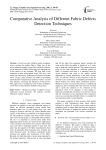
Comparative Analysis of Different Fabric Defects Detection Techniques
Статья научная
In last few years’ different textile companies aim to produce the quality fabrics. Major loss of any textile oriented company occurs due to defective fabrics. So the detection of faulty fabrics plays an important role in the success of any company. Till now most of the inspection is done using human visual. This way is too much time consuming, cumbersome and prone to human errors. In past, many advances are made in developing automated and computerized systems to reduce cost and time whereas, increasing the efficiency of the process. This paper aims at comparing some of these techniques on the basis of classification methods and accuracy.
Бесплатно
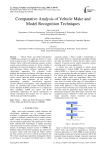
Comparative Analysis of Vehicle Make and Model Recognition Techniques
Статья научная
Vehicle Make and Model Recognition (VMMR) has emerged as a significant element of vision based systems because of its application in access control systems, traffic control and monitoring systems, security systems and surveillance systems, etc. So far a number of techniques have been developed for vehicle recognition. Each technique follows different methodology and classification approaches. The evaluation results highlight the recognition technique with highest accuracy level. In this paper we have pointed out the working of various vehicle make and model recognition techniques and compare these techniques on the basis of methodology, principles, classification approach, classifier and level of recognition After comparing these factors we concluded that Locally Normalized Harris Corner Strengths (LHNS) performs best as compared to other techniques. LHNS uses Bayes and K-NN classification approaches for vehicle classification. It extracts information from frontal view of vehicles for vehicle make and model recognition.
Бесплатно

